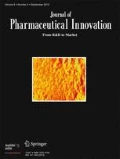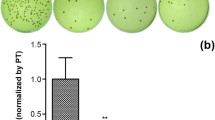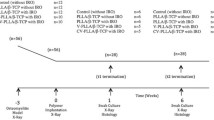Abstract
Purpose
Antibiotic-loaded polymethylmethacrylate has been conventionally used for osteomyelitis treatment, but it requires a second operation for removal. This study aimed to develop and examine the properties of a novel vancomycin-loaded composite fabricated from biodegradable poly(ε-caprolactone)/poly(hydroxybutyrate-co-hydroxyvalerate)/biphasic calcium phosphate (PCL/PHBV/BCP) for chronic methicillin-resistant Staphylococcus aureus (MRSA) osteomyelitis.
Materials and methods
The drug-loaded composite was developed using a solvent casting method and fabricated into four formulations: FV1, FV2, FV3, and FV4. The physicochemical characteristics and osteoblast biocompatibility were evaluated. In addition, the drug-release profile and anti-MRSA activity were examined.
Results
Vancomycin conserved its antibiotic property and did not form any interactions with the raw materials. A loading efficiency of more than 80 % was achieved with all formulations. FV2, FV3, and FV4 demonstrated cumulative release of more than 90 % over a couple of months. The bactericidal property was assessed to confirm the efficacy of the released vancomycin, and all composites showed antibacterial effects over 28 days. The release kinetics were best-fitted with the Korsmeyer–Peppas model, and Fickian diffusion was the main transport mechanism. A cytotoxicity test was also performed, and all formulations showed more than 80 % osteoblast viability.
Conclusions
All of the present in vitro results indicated the effectiveness of the new materials as local vancomycin carriers. In vivo animal models should be evaluated to confirm the efficacy for use in humans in the future.









Similar content being viewed by others
Abbreviations
- MRSA:
-
Methicillin-resistant Staphylococcus aureus
- PMMA:
-
Polymethylmethacrylate
- HA:
-
Hydroxyapatite
- β-TCP:
-
β-Tricalcium phosphate
- BCP:
-
Biphasic calcium phosphate
- PLA:
-
Poly(lactide)
- PGA:
-
Poly(glycolide)
- PCL:
-
Poly(ε-caprolactone)
- PHAs:
-
Polyhydroxyalkanoates
- PHBV:
-
Poly(hydroxybutyrate-co-hydroxyvalerate)
- SEM:
-
Scanning electron microscopy
- XRD:
-
X-ray diffraction pattern
- FTIR:
-
Fourier transformed infrared
- MTT:
-
(3-[4,5-Dimethylthiazol-2-yl]-2,5-diphenyltetrazolium bromide), methyl thiotetrazole
References
Calhoun JH, Manring MM, Shirtliff M. Osteomyelitis of the long bones. Semin Plast Surg. 2009;23:59–72.
Rao N, Ziran BH, Lipsky BA. Treating osteomyelitis: antibiotics and surgery. Plast Reconstr Surg. 2011;127:177–87.
Lazzarini L, Mader JT, Calhoun JH. Osteomyelitis in long bones. J Bone Joint Surg Am. 2004;86:2305–18.
Silva GA, Ducheyne P, Reis RL. Materials in particulate form for tissue engineering. 1. Basic concepts. J Tissue Eng Regen Med. 2007;1:4–24.
Xie Z, Liu X, Jia W, Zhang C, Huang W, Wang J. Treatment of osteomyelitis and repair of bone defect by degradable bioactive borate glass releasing vancomycin. J Control Release. 2009;139:118–26.
Causa F, Netti PA, Ambrosio L, Ciapetti G, Baldini N, Pagani S, et al. Poly-epsilon-caprolactone/hydroxyapatite composites for bone regeneration: in vitro characterization and human osteoblast response. J Biomed Mater Res A. 2006;76:151–62.
Kumar TSS, Manjubala I, Gunasekaran J. Synthesis of carbonated calcium phosphate ceramics using microwave irradiation. Biomaterials. 2000;21:1623–9.
Victor SP, Kumar TS. BCP ceramic microspheres as drug delivery carriers: synthesis, characterisation and doxycycline release. J Mater Sci Mater Med. 2008;19:283–90.
Fellah BH, Gauthier O, Weiss P, Chappard D, Layrolle P. Osteogenicity of biphasic calcium phosphate ceramics and bone autograft in a goat model. Biomaterials. 2008;29:1177–88.
Zhu XD, Fan HS, Xiao YM, Li DX, Zhang HJ, Luxbacher T, et al. Effect of surface structure on protein adsorption to biphasic calcium-phosphate ceramics in vitro and in vivo. Acta Biomater. 2009;5:1311–8.
Freier T. Biopolyesters in tissue engineering applications. Adv Polym Sci. 2006;203:1–61.
Mendes JB, Riekes MK, De Oliveira VM, Michel MD, Stulzer HK, Khalil NM, et al. PHBV/PCL microparticles for controlled release of resveratrol: physicochemical characterization, antioxidant potential, and effect on hemolysis of human erythrocytes. ScientificWorldJournal. 2012;2012:1–13.
Mehrabanian M, Nasr-Esfahani M. HA/nylon 6,6 porous scaffolds fabricated by salt-leaching/solvent casting technique: effect of nano-sized filler content on scaffold properties. Int J Nanomedicine. 2011;6:1651–9.
Sarasua JR, Lopez-Rodriguez N, Zuza E, Petisco S, Castro B, Del Olmo M, et al. Crystallinity assessment and in vitro cytotoxicity of polylactide scaffolds for biomedical applications. J Mater Sci Mater Med. 2011;22:2513–23.
Cetin D, Kahraman AS, Gümüşderelioğlu M. Novel pHEMA-gelatin SPHs as bone scaffolds in dynamic cultures. J Mater Sci Mater Med. 2012;23:2803–12.
Jiang T, Li Y, Lv Y, Cheng Y, He F, Zhuo R. Biodegradable amphiphilic block-graft copolymers based on methoxy poly(ethylene glycol)-b-(polycarbonates-g-polycarbonates) for controlled release of doxorubicin. J Mater Sci Mater Med. 2013;25:131–9.
Mundargi RC, Srirangarajan S, Agnihotri SA, Patil SA, Ravindra S, Setty SB, et al. Development and evaluation of novel biodegradable microspheres based on poly(d, l-lactide-co-glycolide) and poly(epsilon-caprolactone) for controlled delivery of doxycycline in the treatment of human periodontal pocket: in vitro and in vivo studies. J Control Release. 2007;119:59–68.
Wang Q, Wang Q, Wan C. The effect of porosity on the structure and properties of calcium polyphosphate bioceramics. Ceramics. 2011;55:43–8.
Ranjha NM, Ayub G, Naseem S, Ansari MT. Preparation and characterization of hybrid pH-sensitive hydrogels of chitosan-co-acrylic acid for controlled release of verapamil. J Mater Sci Mater Med. 2010;21:2805–16.
Lin SS, Ueng SW, Liu SJ, Chan EC, Chao EK, Tsai CH, et al. Development of a biodegradable antibiotic delivery system. Clin Orthop Relat Res. 1999;362:240–50.
Kankilic B, Bayramli E, Kilic E, Dağdeviren S, Korkusuz F. Vancomycin containing PLLA/beta-TCP controls MRSA in vitro. Clin Orthop Relat Res. 2011;469:3222–8.
Yao Q, Nooeaid P, Roether JA, Dong Y, Zhang Q, Boccaccini AR. Bioglass®-based scaffolds incorporating polycaprolactone and chitosan coatings for controlled vancomycin delivery. Ceram Int. 2013;39:7517–22.
Canut A, Isla A, Betriu C, Gascóm AR. Pharmacokinetic-pharmacodynamic evaluation of daptomycin, tigecycline, and linezolid versus vancomycin for the treatment of MRSA infections in four western European countries. Eur J Clin Microbiol Infect Dis. 2012;31:2227–35.
Dorozhkin SV. Biocomposites and hybrid biomaterials based on calcium orthophosphates. Biomatter. 2011;1:3–56.
Tang CY, Chen DZ, Yue TM, Chan KC, Tsui CP, Yu PHF. Water absorption and solubility of PHBHV/HA nanocomposites. Compos Sci Technol. 2008;68:1927–34.
Urabe K, Naruse K, Hattori H, Hirano M, Uchida K, Onuma K, et al. In vitro comparison of elution characteristics of vancomycin from calcium phosphate cement and polymethylmethacrylate. J Orthop Sci. 2009;14:784–93.
Rossi S, Azghani AO, Omri A. Antimicrobial efficacy of a new antibiotic-loaded poly(hydroxybutyric-co-hydroxyvaleric acid) controlled release system. J Antimicrob Chemother. 2004;54:1013–8.
International Organization for Standardization. Biological evaluation of medical devices—Part 5: Tests for in vitro cytotoxicity (ISO 10993–5:2009). Geneva: ISO; 2009. p. 1–34.
Ning Z, Xiongbiao C. Biofabrication of tissue scaffolds. In: Pignatello R, editor. Advances in biomaterials science and biomedical applications. Rijeka: InTech; 2013. p. 315–28.
Yang CC, Lin CC, Liao JW, Yen SK. Vancomycin-chitosan composite deposited on post porous hydroxyapatite coated Ti5Al4V implant for drug controlled release. Mater Sci Eng C Mater Biol Appl. 2013;33:2203–12.
Li W, Nooeaid P, Roether JA, Schubert DW, Boccaccini AR. Preparation and characterization of vancomycin releasing PHBV coated 45S5 Bioglass®-based glass-ceramic scaffolds for bone tissue engineering. J Eur Ceram Soc. 2014;34:505–14.
Korsmeyer RW, Gurny R, Doelker E, Buri P, Peppas NA. Mechanisms of solute release from porous hydrophilic polymers. Int J Pharm. 1983;15:25–35.
Soundrapandian C, Datta S, Kundu B, Basu D, Sa B. Porous bioactive glass scaffolds for local drug delivery in osteomyelitis: development and in vitro characterization. AAPS PharmSciTech. 2010;11:1675–83.
Acknowledgments
This work was supported by the Faculty of Medicine, Prince of Songkla University, Songkhla, Thailand, under grant EC 522821142. The authors would like to thank Dr. Naruporn Monmaturapot from MTEC, Thailand, for the BCP syntheses and Assoc. Prof. Dr. Chitchamai Ovartlanporn, Department of Pharmaceutical Chemistry, Faculty of Pharmaceutical Sciences, Prince of Songkla University, Thailand, for the chemical analyses.
Author information
Authors and Affiliations
Corresponding author
Rights and permissions
About this article
Cite this article
Upho, N., Tangtrakulwanich, B., Pripatnanont, P. et al. Development of Novel PHBV/PCL and BCP Composite for Musculoskeletal Infection: an In Vitro Vancomycin Release and Anti-MRSA Effect. J Pharm Innov 10, 211–221 (2015). https://doi.org/10.1007/s12247-015-9219-4
Published:
Issue Date:
DOI: https://doi.org/10.1007/s12247-015-9219-4




